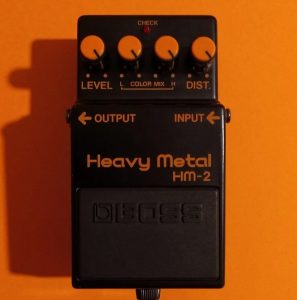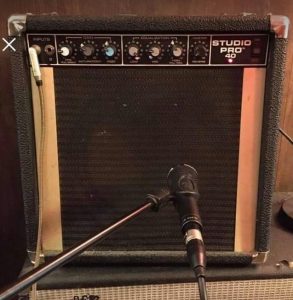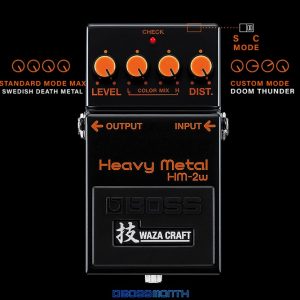Landmark Metal Production Styles – Swedish Death Metal
Since its inception in the late sixties, metal has gone through a staggering evolutionary process throughout the years both musically and sonically.
With each new decade since its invention, Metal’s gnarled blackened branches have continued to twist and contort into new glorious abominations. Each permutation shaping itself into new genres and sub genres alike which spread out into new directions of their own.
All the while, these variations on the original recipe somehow maintain a connection with the tree its branches extend from.
This is a guest post by top rated AirGigs artist Aaron Cloutier
These days, you can find anything from Classic Heavy Metal, Thrash Metal, Speed Metal, Death Metal, Black Metal, Christian Metal, Metalcore, Dent, Progressive Metal, Grindcore, Deathcore, Swedish Death Metal, Swedish Melodic Death Metal, Symphonic Metal, Folk Metal and who knows what else I’m missing here?
What brings these seemingly disparate musical styles together is the fact that they were born out of a desire for things to be more than what came before in some way. Whether the music needed to be faster, heavier, more intense, more melodic, more musically adventurous, or more technical, all of these musical styles push the envelope in some way shape or form.
Equally, there have been a number of producers whose landmark production styles have helped shaped the sound of each of these sub-genres and laid the groundwork for how metal music sounds today.
With that in mind, I’m going to shine a light on what I feel to be three of the most influential production styles in each of these distinct genres that are still heard in metal today over the course of multiple articles. Specifically, I’m going to be talking about where these production styles came from, how they are achieved, and where they fit into today’s modern metal musical
landscape.
By the end of each article, you should be able to walk away with some new insights into How to produce and “mix” your own song.
Landmark Styles – Swedish Death Metal (Swedeath)
In today’s article, we’re going to take it all the way back to late 1980’s Scandinavia to dissect the history behind the now legendary Sunlight Studio sound. We’re going to discuss a bit of the history behind the recordings, where it’s influence fits in today’s musical landscape, and how you can capture the that distinctive HM-2 sound in your session.
Let us feast.
Part One: The History
So who invented Swedish Death Metal anyway?
All signs point back to a demo entitled “Only Shreds Remain” by a little unknown
band by the name of “Nihilist.”
Released in 1989, the demo clocks in at a little over ten minutes but the impact of it’s three monstrous tracks was, and remains, undeniable. With rhythms ranging from slow and swampy to breakneck and bludgeoning to demonic guttural vocals drenched in reverb and a guitar sound wrapped in barbed wire. “Only Shreds Remain” was the blueprint of what would come to be known as the “Sunlight Studio Sound.”
Not familiar with Nihilist? Well, you probably know them better nowadays by their
second name. The legendary “Entombed.”
Here’s a bit of backstory…
How poor social skills gave birth to a genre.
Comprised of teenagers at the time, things weren’t exactly a good fit between Nihilist and their bassist at the time Jonny Hedlund. The rest of the band knew they wanted to get rid of him but didn’t really know how to go about breaking the
news.
They decided that the best course of action would be to just “split up” and then later reform under a new name without him. Thus, “Entombed” were born.
Hedlund on the other hand didn’t seem to miss a beat and went on to form the renowned “Unleashed.” One of the first death metal bands to incorporate Viking/Scandinavian history and heritage into their songwriting instead of defaulting to the typical horror movie subject matter of their contemporaries.
Now if that’s not turning a frown upside down right there, I don’t know what is. It makes me wonder what would have happened if these kids used their words when addressing uncomfortable conversations. Perhaps neither of these bands would’ve
existed. Hooray teenage passive aggression!
Part Two : The Sound
What initially makes Swedish Death Metal so sonically distinct from its extreme metal contemporaries is without a doubt its aforementioned signature guitar sound. A tone characterized by its ample midrange, biting top end and furnace like sustain.
So how did it come to be?
It has been reported that while experimenting in the studio during the Nihilist recording sessions, late guitarist Leif Cuzner wound up cranking all the knobs on his Boss HM-2 pedal to the utmost, and, subsequently gave birth to the first iterations of the buzzsaw sound.

Though some note definition may be sacrificed in the process compared to more contemporary metal tones, the end result is a gnarly wall of sound that’s as thick and wooly as it is viciously sharp. Honestly, anytime I hear it, it feels like I’m enveloped by a massive sweater with a bunch of razor blades sticking out of it….But like, in a good way!
Innovation born out of necessity.
Though the Sunlight Studio sound has achieved legendary status amongst the Metal community over the years, what surprised me the most is how the sound came to be in the first place. Because the majority of these bands were comprised of teenagers, there wasn’t much of a budget to go around for getting a demo made back in those days. On top of that, producer Tomas Skogsburg had never attempted recording metal before and had to figure out a way to capture that buzzsaw guitar sound in the studio for very little krona.
The end result is a testament to the creative freedom found within the confines of supposed “limitations.” By using a barebones approach on cheap gear, a unique sound was captured that is still celebrated today. With that in mind, I want to offer you two different approaches on how to recreate these tones in your studio.
How To Achieve The Sunlight Sound In The Studio – Analog
If you want to do it like the Swedes did way back when, it’s important to know that like many things in music, achieving a specific sound is due to a combination of elements as oppose to controlling one single variable. Yes getting your grubby mitts on an HM-2 and diming all the potentiometers to 11 is a great start but here’s what else you’ll need if you want to go old school.
Step one. Grab yourself a good ol’ Peavy studio pro 40 and match the exact settings shown in the photo below to achieve the “buzzsaw” guitar sound.

Step two: Grab an Audio-Technica ATM41 microphone and place it right outside the center of the speaker cone as shown above.
Step three: Get yourself the now infamous BOSS HM2 pedal and crank everything single knob on that bad boy all the way to the right.

Step four: Tune your guitar to B standard. I’ve provided tunings for both six and seven string guitars.
▶▶ Six string guitar: Low to High: B – E – A – D – F# – B
▶▶ Seven string guitar: Low to High: B – E – A – D – F# – B – E
A word about strings:
If you’re going for that classic “Left Hand Path” sound, slap on some 10 to 46 gauge strings to recreate some of that nice looseness heard on the record.
If you really want to go crazy authentic, record all the rhythm guitars on an Ibanez X-series while tracking any lead guitar work on a B.C. Rich but it’s really not necessary to recreate tones in all honesty.
Side note: If 10 to 46 gauges are a little too sloppy jalopy for you, try out a set of D’addario 12-60 gauge strings as recommended by Sentient Horror guitarist/vocalist/mastermind Matt Moliti.
Cabinets.
An often overlooked component of most guitar tones is the speaker cabinet. Swede producer DemiGod Dan Swanö always swore by the speaker cab being the most vital component in the over all guitar sound. If you’re re-amping in the studio or working with impulse responses in the box, find a 1×12 open back combo (or a plugin emulation equivalent) to record with for the best results.
How To Achieve The Sound – Digital
This is a much more straightforward approach as all it takes these days is a single plugin to replicate classic guitar sounds. Yes, it might seem like it’s cheating a bit but if you’re a home studio musician, you don’t me to tell you of the challenges one faces when working in loud music during late hours amongst neighbors. If convenience is what you’re after, then plug-ins are your way to go.
A couple that I can recommend right off the bat are the following:
▶▶ Toontrack Ez Mix 2 – Modern Metal expansion – “Made In Sweden” preset
▶▶ Toontrack Ez Mix 2 – Death Metal expansion – “Old School Swedish” preset
▶▶ If you’re not lazy like me, here’s how to create HM-2 tones using free plugins.
▶▶ Here’s how to create HM-2 tones with Amplitude 4:
The hidden ingredient
Because the HM-2 sound in its original form is so dense and distorted, the addition of a Boss DS-1 distortion pedal was brought in to add clarity to the guitar sound in the studio back in those days.
▶▶ To recreate the sound of a Boss DS-1 using stock plugins, check out this video
here.
▶▶ Check that out here
https://www.plugin-alliance.com/en/products/bx_distorange.html
Part Three : How To Mix Sunlight Studio Guitars In Your DAW
For the purposes of this article, we’re going to take a page out of Entombed’s book as they mixed their music in a very specific way.
First, we’re going to record the same riff three times.
Two of these tracks will receive the HM2 treatment while the third will be our DS-1.
The HM2 guitars are going to be panned hard left and hard right.
Our DS-1 track is going to go right up the center.
This technique can be heard all over Entombed’s “Left Hand Path” record. If you reference it with decent headphones/monitors you’ll hear what I’m talking about. How Sunlight Studio’s Impact Is Still Felt Today
The HM-2 sound is alive and well with a host of new bands ushering in a new generation of demonic fuzz shrapnel. From old school stalwarts like Bloodbath and Black Breath to newcomers like Sentient Horror and Gatecreeper, there’s no shortage of bands waving the flag for the classic Sunlight Studio inspired sound.
What is particularly promising to me is to see the ones who branch out to create their own sound to set themselves apart in the ever saturated music scene. From the frenetic grind core of bands like Nails to the melodic near Black Metal
atmospherics of a band like Horrendous, these and a host of others in the new
crop are once again pushing the envelope and forging new paths with the classic
HM-2 sound.
To the uninitiated
If you’re new to the whole “Swedeath” thing and are looking to do a deep dive, I’ve included below a modest list of bands to get your start.
Have a band you feel worthy to include? Drop a comment with your recommendation to let us know!
Thanks for reading. If this is something you’d like to see more of, which genre should I tackle next?
-Aaron-
List of classic “Sunlight Studio” Swedish Death Metal bands
utilizing the HM-2 sound
Entombed
Dismember
Unleashed
List of modern bands utilizing the HM-2 sound
Nails
Gatecreeper
Entrails
Horrendous
Black Breath
Sentient Horror

